
The Project Gutenberg EBook of Cactus Forest Drive, Saguaro National Monument, by Anonymous This eBook is for the use of anyone anywhere in the United States and most other parts of the world at no cost and with almost no restrictions whatsoever. You may copy it, give it away or re-use it under the terms of the Project Gutenberg License included with this eBook or online at www.gutenberg.org. If you are not located in the United States, you'll have to check the laws of the country where you are located before using this ebook. Title: Cactus Forest Drive, Saguaro National Monument Author: Anonymous Release Date: June 21, 2019 [EBook #59787] Language: English Character set encoding: UTF-8 *** START OF THIS PROJECT GUTENBERG EBOOK CACTUS FOREST DRIVE *** Produced by Stephen Hutcheson, Lisa Corcoran and the Online Distributed Proofreading Team at http://www.pgdp.net

Cover picture by George Olin.
SAGUARO NATIONAL MONUMENT
18 Miles East of Tucson, Arizona
15¢
Saguaro National Monument is one of more than 175 units administered by the National Park Service, U. S. Department of the Interior. They include such outstanding scenic areas as Grand Canyon and Yosemite National Parks and other Parks and Monuments set aside for their scenic, scientific, historic or archeologic values. These superb areas are yours and are a part of your heritage as American citizens.
The National Park Service has the job of preserving the Parks and Monuments in their natural, unspoiled condition and of making them available for your enjoyment in such a manner as to leave them unimpaired for the inspiration of future generations. To achieve this high purpose it has been necessary to prohibit such activities as woodcutting, hunting, grazing, mining and even flower-picking. The men in the uniform of the National Park Service are here to serve you, and will welcome the opportunity to make your stay at Saguaro National Monument more enjoyable.
We hope you will cooperate with us “by taking only pictures and inspiration and leaving only footprints and goodwill.”
Photographers will note that several trails have been laid out for their convenience. These lead to particularly fine specimens and groups of Saguaros, but have not been developed as permanent trails. They are merely guides to the better photographic locations.
The best time to photograph the Cactus Forest is late in the afternoon when the lengthening shadows make the cactus stand out in bold relief. Excellent views of the forest, with the Santa Catalina Mountains in the background, may be had from the hilltops as you drive north on the loop road. The Arizona sun is brighter than you think, so use a light meter.
If you are interested in the work of the National Park Service and in the cause of conservation in general, you can give active expression of this interest, and lend support by aligning yourself with one of the numerous conservation organizations which act as spokesmen for those who wish our scenic heritage to be kept unimpaired for the enjoyment of future generations.
Names and addresses of conservation organizations may be obtained from the ranger.
KEEP AMERICA BEAUTIFUL

Ray Manley photo
In 1933 President Herbert Hoover by presidential proclamation created Saguaro National Monument. Within its boundaries is found the magnificent forest of mature Saguaros that is recognized as the finest stand of this great cactus in the United States. It is one of the few National Monuments dedicated to the protection and preservation of a native plant species.
It is also one of the most diversified of our National Monuments. With an altitudinal range of over 5,000 feet its 63,000-acre area encompasses the peaks of two mountain ranges. Against this background of towering mountains the cactus forest is presented as a rare jewel mounted in an incomparable setting.
The Saguaro (Carnegiea gigantea) is the largest cactus native to the United States. Common in northwestern Mexico, its range north of the border is limited to southern Arizona, with the exception of a few isolated small colonies along the California side of the Colorado river. It grows on low desert plains and foothills in the hot dry climate of the Lower Sonoran Zone. A prominent feature of this desert landscape is the great variety of xerophytic (especially modified to exist on limited water supply) plants, especially the cacti. In response to the arid conditions under which it must survive the Saguaro exhibits a degree of adaptability equalled by few plants anywhere.
The construction of the Saguaro is simple, yet effective. The stem is supported by an inner framework of from 12 to 30 slender vertical ribs. Arranged in a circle and joined at various places these ribs form an openwork tube that possesses great strength and rigidity. In and around this tube is a spongy tissue capable of absorbing a great amount of water. This is facilitated by the accordion-like pleats of the interior surface of the stem. These extend or close together as the moisture content of the plant increases or diminishes.
The roots that serve this living storage tank are no less remarkable. The tap root is small and acts as little more than a pad to support the great weight of the plant. The radial roots are heavy and of great length. They radiate out from the base of the Saguaro, usually no more than a foot below the surface of the ground, but often to a distance equal to the height of the plant. They serve the double purpose of gathering food and moisture, and of holding the great bulk of the trunk upright against the fierce desert storms. In their progress 3 through the rocky soil in which the Saguaro usually grows they become contorted and act as anchors which are not easily dislodged.

George Olin Photo
The red pulp and shiny black seeds of
the Saguaro fruit are eagerly taken by
almost all animals. Even man finds it
delicious. The scarlet lining of the
opened and split pod is often mistaken
by newcomers for a red flower.
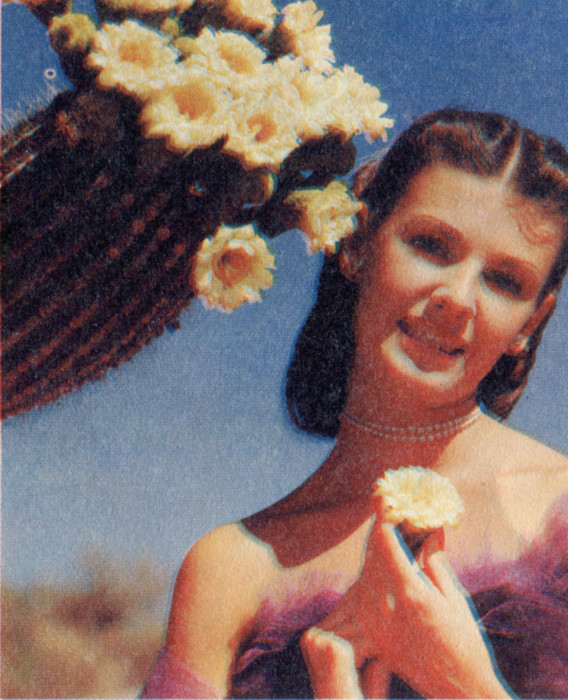
Ray Manley Photo
The Saguaro blooms at night, and on
bright days closes about 10 the next
morning. They attract swarms of insects,
which in turn lure many birds.
This is the state flower of Arizona
and blooms in May and June.
The associations of the Saguaro with other plants of the desert have not as yet been fully studied. However, it is apparent that for the first years of its life the young Saguaro seedling requires the protection furnished by a shrub or tree. Here it makes slow but steady progress until at 50 years of age it may be 10 to 12 feet tall. During the next century it may attain a height of 40 feet and a weight of several tons, dwarfing its protector of former years.
The ecological importance of the Saguaro to animals is better known. Two species of Woodpeckers, the Gila Woodpecker and the Gilded Flicker, drill deep holes into the plant and fashion nests in the cool interior. Actually this causes little damage to the Saguaro, which soon forms a thick scar tissue around the walls of the excavation, sealing it away from the rest of the plant. In succeeding years these nests may be taken over by Elf Owls, Sparrow Hawks, Flycatchers, or Purple Martins. Larger birds build their nests among the branches of the Saguaro. Chief among these are the Red Tail Hawks and Great Horned Owls.

Ray Manley Photo
YUCCA BLOOMS
Yucca elata (Palmilla, Soapweed) is one of the best known plants of the Southwest. The beautiful white plumes of flowers appear in May and June.
While at Saguaro you will find it is desirable to take advantage of the recreational and educational facilities provided for your use. After you leave the Administration Building, signs along the 9.1-mile loop road will direct your attention to special exhibits along the way. Each area has been chosen because of features especially interesting to the visitor. Limited exploring and hiking trips are encouraged along Cactus Forest Drive. A picnic area provided with fireplaces, tables and ramadas is located at the 8-mile point.
Among the many stops along the Cactus Forest Drive five have been selected as especially important to an understanding of the natural features of the Monument. Each has “in place” information which will add to your appreciation of the Cactus Forest.
ROCK PARAPET—Approximately 200 years ago prevailing climatic conditions were of such nature as to permit germination of a large number of Saguaro seeds, creating the more or less even-aged stand of Giant Saguaros we see here today.
The Tanque Verde Mountains to the east are composed largely of crystalline rocks formed under conditions of great heat and pressure. They were elevated by movements of the earth’s crust and now are gradually being eroded away.
The Tucson Valley to the north is in reality a deep canyon (2,000 to 3,000 feet) filled with debris.
CRISTATE SAGUARO—This abnormal growth, called a cristate, is of rare occurrence. Many theories have been advanced as to what causes these “crests” but none hold true in all cases. Although the cause is unknown, the pattern of their growth is simple. Instead of growing in three directions the cells of a cristate grow only upward and outward in two. This results in a fan-shaped malformation with a long growing line in the center of the upper edge. Although a cristate may apparently develop from an injury, there is every reason to believe that, once established, the tendency to cristate becomes a genetic character. Seed from cristates often produce cristate plants. An excellent specimen of cristate Barrel Cactus may be seen at the entrance to the Nature Trail.
NATURE TRAIL—Along this 300-yard trail you will find most of the important plants native to the Cactus Forest. Each plant is labelled with both common and scientific names, together with much additional information.
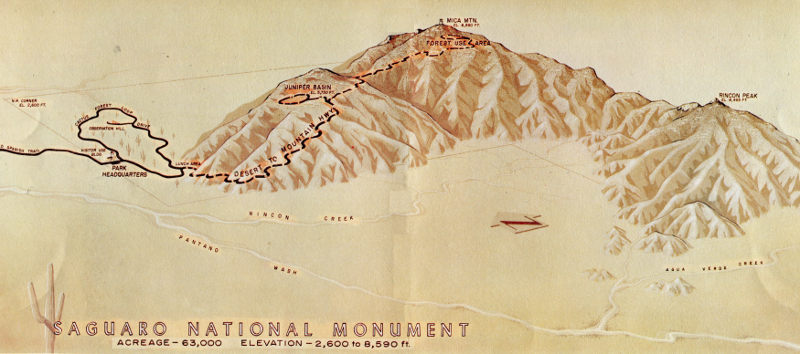
THE DESERT AND THE MOUNTAINS
The Tanque Verde (green tank) and Rincon (inside corner) Mountains are an important part of Saguaro National Monument. This is presently the “back country” of the monument. The mountainous section has a wide variety of interests in the field of biology. The range of climates and life zones combine to make one of the most interesting stories to be found in any of your national parks or monuments.

George Olin Photo
Redtail Hawk
This large Buteo is a common resident of the Monument. It frequently nests among the arms of the Saguaro. Since its food consists mainly of small rodents it is one of the most beneficial of our birds.
VIEW OF WEST SLOPE OF TANQUE VERDE MOUNTAINS—Saguaro cacti growing up to an elevation of 4,000 feet.
The country you see here is a good example of what is called the Lower Sonoran life zone. Here you may expect such typical desert animals as the Roadrunner, Gambel Quail, Kangaroo Rat, Jackrabbit and the Javelina or “wild pig”.
JAVELINA DEN (hah-veh-LEE-nah)—In these undercuts the Javelinas (or Peccary) often hide during the day to escape from the heat of the sun. At night many Javelinas are often present in this particular area due to the abundance of Jojoba bushes.
From the view point near the Javelina Den a striking view may be had of the distant Santa Cruz Valley. On a clear day seven mountain ranges may be seen from this spot.

Screech Owl—These small grayish owls (usually with more conspicuous “ear” tufts) are permanent and valued residents of the Saguaro country. On their silent night-time hunts they eat great numbers of mice and insects.
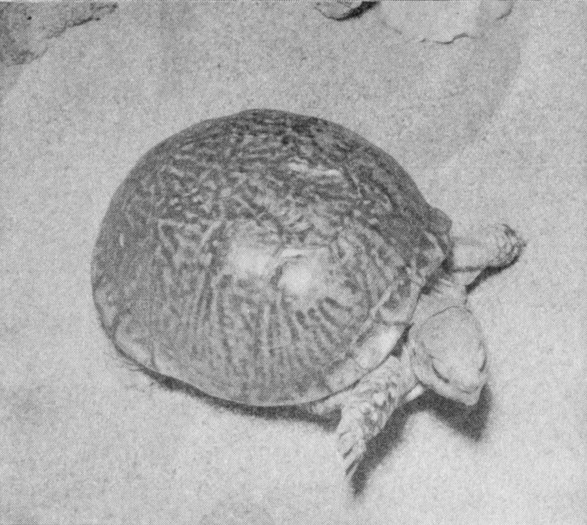
Western Box Turtle—Occasionally observed in the Cactus Forest.
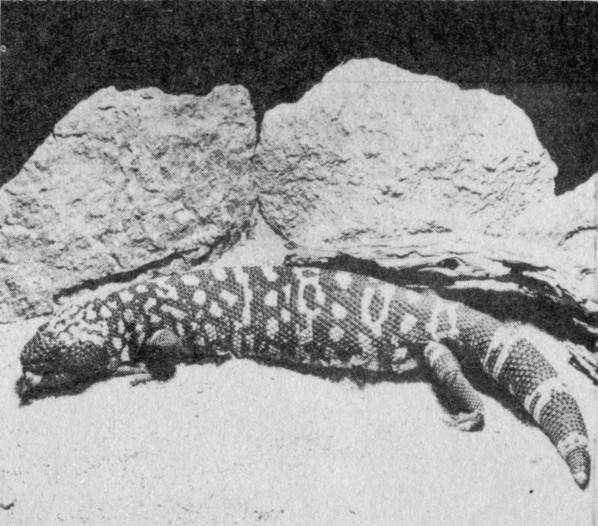
Gila (Hee-lah) Monster—The only poisonous lizard in the United States; it is protected in Arizona by law. Its skin is beaded and its color is marbled black with pinkish or yellowish. The Gila Monster reproduces by eggs which are laid in the sand.
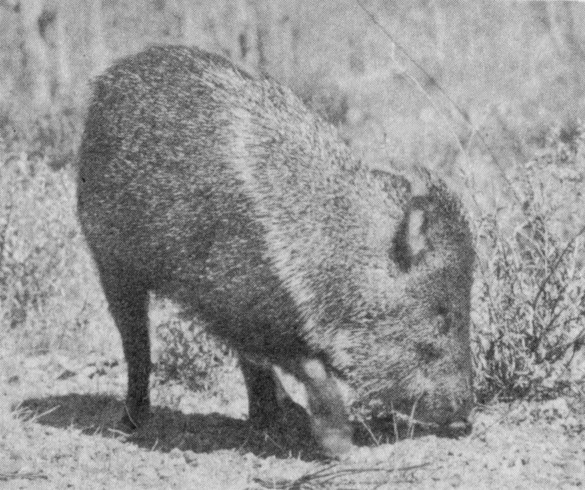
Peccary—Bands of peccaries, so-called wild pigs, are commonly seen along the Cactus Forest Drive.
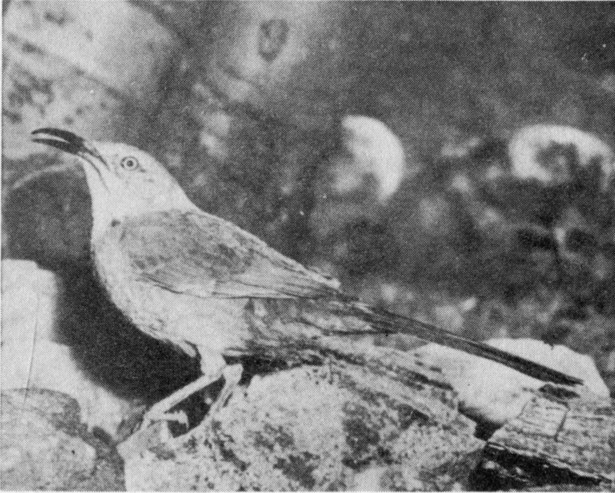
Palmer Thrasher—Robin-sized, with curved bill, long tail and gray-brown back. Often nests in the Cholla Cactus.

Mexican Mule Deer—Most people are accustomed to thinking of deer as animals of the forest, but surprisingly enough the rough foothill country in the desert supports a large population of deer. The Mule Deer is a true vegetarian and during the fall and winter browses extensively on trees and shrubs and during spring and summer consumes a variety of grasses and herbs. The young are born in late spring or summer and the fawns are sometimes seen at that time of year.

Gilded Flicker—Many of the small holes in the Saguaros were made by this bird as it hollows out a cavity for its nest.

Roadrunner—This odd looking, ground-dwelling relative of the Cuckoos resides in brushy places throughout the Southwest. It eats insects, spiders, lizards, small snakes and mice. Rattlesnakes sometimes are killed by Roadrunners.
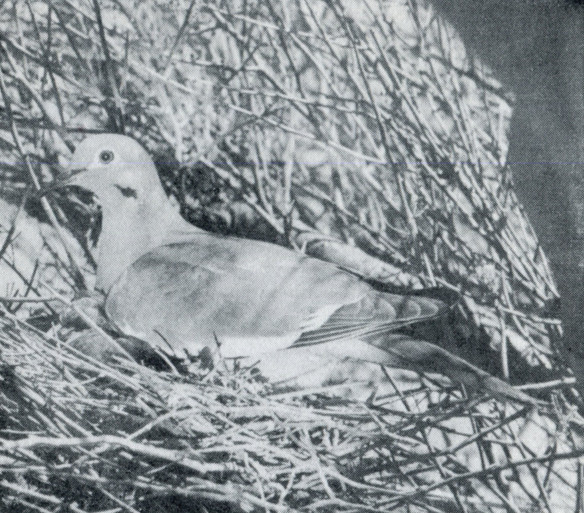
Whitewinged Dove—Large numbers of these birds may be seen in the Cactus Forest when the Saguaro fruits are ripe.
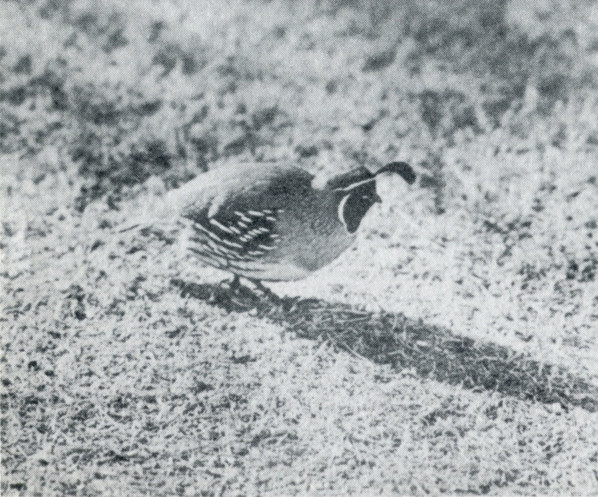
Gambel Quail—A common desert dweller that may be observed at any season of the year. It nests on the ground.
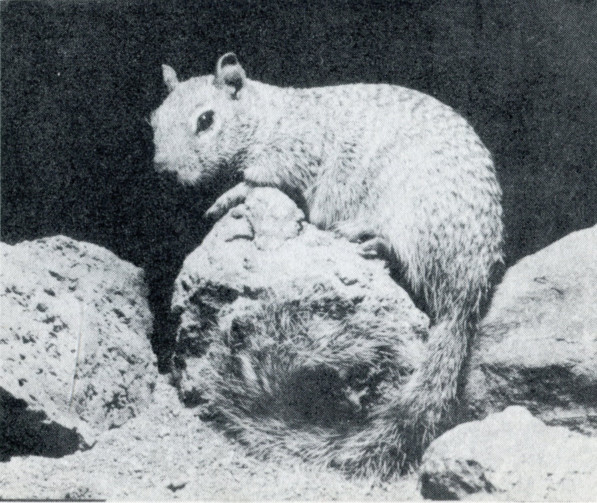
Arizona Rock Squirrel—Distinguished from the Gray Squirrels by their less bushy tail and mottled coat. They are ground dwellers, but can climb trees if necessary.

White-throated Wood Rat—Commonly known as the Pack Rat, this interesting animal builds its nest in a mound of cactus segments. Marauders think twice before they molest this spiny home. Seldom seen in daylight. Note the baby, lower left.

Above—Harris Ground Squirrel—A small ground squirrel with striped back and a bushy tail usually held erect. They are active during the day and may be seen from April through November.
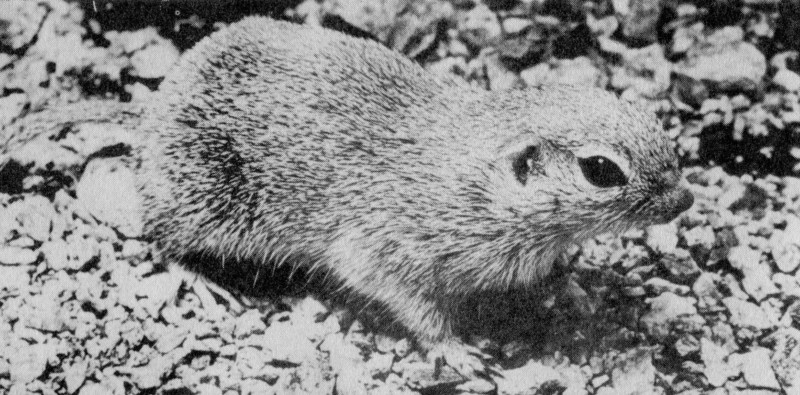
Below—Arizona Round-tailed Ground Squirrel—Another common ground squirrel of the desert. It has a short tail and is tan in color.
“All photographs on pages 9-12 by Marvin H. Frost, Sr.”
5th Ed. 4-56 20M
Saguaro National Monument, a unit of the National Park System, is one of 180 areas administered by the National Park Service, U. S. Department of the Interior.
The traveling public is becoming increasingly aware of the National Monuments, which have received less publicity than the great, well-known National Parks, yet which possess extremely interesting features.
Many of these are in the Southwest; we hope you will take the opportunity to visit one or more of them on your trip.
Administered as a group by the General Superintendent, Southwestern National Monuments, Box 1562, Gila Pueblo, Globe, Arizona
Other areas administered by the National Park Service in the Southwest follow:
This booklet is published by the
SOUTHWESTERN NATIONAL MONUMENTS
Box 1562 H, Gila Pueblo, Globe, Arizona
which is a non-profit distributing organization pledged to aid in the preservation
and interpretation of Southwestern features of outstanding national interest.
The Association lists for sale interesting and excellent publications for adults and children and very many color slides on Southwestern subjects. These make fine gifts for birthdays, parties, and special occasions, and many prove to be of value to children in their school work and hobbies.
May we recommend, for instance, the following items which give additional information on Saguaro National Monument and the Southwest?
For the complete list of almost 100 publications and 1700 color slides on Southwestern Indians, geology, ruins, plants, animals, history, etc., ask the Ranger, or you can obtain one by mail by writing the
SOUTHWESTERN
NATIONAL MONUMENTS
Box 1562 H—Gila Pueblo, Globe, Arizona

Offset by KILLIAN PRINTING SERVICE
GLOBE, ARIZONA
End of the Project Gutenberg EBook of Cactus Forest Drive, Saguaro National
Monument, by Anonymous
*** END OF THIS PROJECT GUTENBERG EBOOK CACTUS FOREST DRIVE ***
***** This file should be named 59787-h.htm or 59787-h.zip *****
This and all associated files of various formats will be found in:
http://www.gutenberg.org/5/9/7/8/59787/
Produced by Stephen Hutcheson, Lisa Corcoran and the Online
Distributed Proofreading Team at http://www.pgdp.net
Updated editions will replace the previous one--the old editions will
be renamed.
Creating the works from print editions not protected by U.S. copyright
law means that no one owns a United States copyright in these works,
so the Foundation (and you!) can copy and distribute it in the United
States without permission and without paying copyright
royalties. Special rules, set forth in the General Terms of Use part
of this license, apply to copying and distributing Project
Gutenberg-tm electronic works to protect the PROJECT GUTENBERG-tm
concept and trademark. Project Gutenberg is a registered trademark,
and may not be used if you charge for the eBooks, unless you receive
specific permission. If you do not charge anything for copies of this
eBook, complying with the rules is very easy. You may use this eBook
for nearly any purpose such as creation of derivative works, reports,
performances and research. They may be modified and printed and given
away--you may do practically ANYTHING in the United States with eBooks
not protected by U.S. copyright law. Redistribution is subject to the
trademark license, especially commercial redistribution.
START: FULL LICENSE
THE FULL PROJECT GUTENBERG LICENSE
PLEASE READ THIS BEFORE YOU DISTRIBUTE OR USE THIS WORK
To protect the Project Gutenberg-tm mission of promoting the free
distribution of electronic works, by using or distributing this work
(or any other work associated in any way with the phrase "Project
Gutenberg"), you agree to comply with all the terms of the Full
Project Gutenberg-tm License available with this file or online at
www.gutenberg.org/license.
Section 1. General Terms of Use and Redistributing Project
Gutenberg-tm electronic works
1.A. By reading or using any part of this Project Gutenberg-tm
electronic work, you indicate that you have read, understand, agree to
and accept all the terms of this license and intellectual property
(trademark/copyright) agreement. If you do not agree to abide by all
the terms of this agreement, you must cease using and return or
destroy all copies of Project Gutenberg-tm electronic works in your
possession. If you paid a fee for obtaining a copy of or access to a
Project Gutenberg-tm electronic work and you do not agree to be bound
by the terms of this agreement, you may obtain a refund from the
person or entity to whom you paid the fee as set forth in paragraph
1.E.8.
1.B. "Project Gutenberg" is a registered trademark. It may only be
used on or associated in any way with an electronic work by people who
agree to be bound by the terms of this agreement. There are a few
things that you can do with most Project Gutenberg-tm electronic works
even without complying with the full terms of this agreement. See
paragraph 1.C below. There are a lot of things you can do with Project
Gutenberg-tm electronic works if you follow the terms of this
agreement and help preserve free future access to Project Gutenberg-tm
electronic works. See paragraph 1.E below.
1.C. The Project Gutenberg Literary Archive Foundation ("the
Foundation" or PGLAF), owns a compilation copyright in the collection
of Project Gutenberg-tm electronic works. Nearly all the individual
works in the collection are in the public domain in the United
States. If an individual work is unprotected by copyright law in the
United States and you are located in the United States, we do not
claim a right to prevent you from copying, distributing, performing,
displaying or creating derivative works based on the work as long as
all references to Project Gutenberg are removed. Of course, we hope
that you will support the Project Gutenberg-tm mission of promoting
free access to electronic works by freely sharing Project Gutenberg-tm
works in compliance with the terms of this agreement for keeping the
Project Gutenberg-tm name associated with the work. You can easily
comply with the terms of this agreement by keeping this work in the
same format with its attached full Project Gutenberg-tm License when
you share it without charge with others.
1.D. The copyright laws of the place where you are located also govern
what you can do with this work. Copyright laws in most countries are
in a constant state of change. If you are outside the United States,
check the laws of your country in addition to the terms of this
agreement before downloading, copying, displaying, performing,
distributing or creating derivative works based on this work or any
other Project Gutenberg-tm work. The Foundation makes no
representations concerning the copyright status of any work in any
country outside the United States.
1.E. Unless you have removed all references to Project Gutenberg:
1.E.1. The following sentence, with active links to, or other
immediate access to, the full Project Gutenberg-tm License must appear
prominently whenever any copy of a Project Gutenberg-tm work (any work
on which the phrase "Project Gutenberg" appears, or with which the
phrase "Project Gutenberg" is associated) is accessed, displayed,
performed, viewed, copied or distributed:
This eBook is for the use of anyone anywhere in the United States and
most other parts of the world at no cost and with almost no
restrictions whatsoever. You may copy it, give it away or re-use it
under the terms of the Project Gutenberg License included with this
eBook or online at www.gutenberg.org. If you are not located in the
United States, you'll have to check the laws of the country where you
are located before using this ebook.
1.E.2. If an individual Project Gutenberg-tm electronic work is
derived from texts not protected by U.S. copyright law (does not
contain a notice indicating that it is posted with permission of the
copyright holder), the work can be copied and distributed to anyone in
the United States without paying any fees or charges. If you are
redistributing or providing access to a work with the phrase "Project
Gutenberg" associated with or appearing on the work, you must comply
either with the requirements of paragraphs 1.E.1 through 1.E.7 or
obtain permission for the use of the work and the Project Gutenberg-tm
trademark as set forth in paragraphs 1.E.8 or 1.E.9.
1.E.3. If an individual Project Gutenberg-tm electronic work is posted
with the permission of the copyright holder, your use and distribution
must comply with both paragraphs 1.E.1 through 1.E.7 and any
additional terms imposed by the copyright holder. Additional terms
will be linked to the Project Gutenberg-tm License for all works
posted with the permission of the copyright holder found at the
beginning of this work.
1.E.4. Do not unlink or detach or remove the full Project Gutenberg-tm
License terms from this work, or any files containing a part of this
work or any other work associated with Project Gutenberg-tm.
1.E.5. Do not copy, display, perform, distribute or redistribute this
electronic work, or any part of this electronic work, without
prominently displaying the sentence set forth in paragraph 1.E.1 with
active links or immediate access to the full terms of the Project
Gutenberg-tm License.
1.E.6. You may convert to and distribute this work in any binary,
compressed, marked up, nonproprietary or proprietary form, including
any word processing or hypertext form. However, if you provide access
to or distribute copies of a Project Gutenberg-tm work in a format
other than "Plain Vanilla ASCII" or other format used in the official
version posted on the official Project Gutenberg-tm web site
(www.gutenberg.org), you must, at no additional cost, fee or expense
to the user, provide a copy, a means of exporting a copy, or a means
of obtaining a copy upon request, of the work in its original "Plain
Vanilla ASCII" or other form. Any alternate format must include the
full Project Gutenberg-tm License as specified in paragraph 1.E.1.
1.E.7. Do not charge a fee for access to, viewing, displaying,
performing, copying or distributing any Project Gutenberg-tm works
unless you comply with paragraph 1.E.8 or 1.E.9.
1.E.8. You may charge a reasonable fee for copies of or providing
access to or distributing Project Gutenberg-tm electronic works
provided that
* You pay a royalty fee of 20% of the gross profits you derive from
the use of Project Gutenberg-tm works calculated using the method
you already use to calculate your applicable taxes. The fee is owed
to the owner of the Project Gutenberg-tm trademark, but he has
agreed to donate royalties under this paragraph to the Project
Gutenberg Literary Archive Foundation. Royalty payments must be paid
within 60 days following each date on which you prepare (or are
legally required to prepare) your periodic tax returns. Royalty
payments should be clearly marked as such and sent to the Project
Gutenberg Literary Archive Foundation at the address specified in
Section 4, "Information about donations to the Project Gutenberg
Literary Archive Foundation."
* You provide a full refund of any money paid by a user who notifies
you in writing (or by e-mail) within 30 days of receipt that s/he
does not agree to the terms of the full Project Gutenberg-tm
License. You must require such a user to return or destroy all
copies of the works possessed in a physical medium and discontinue
all use of and all access to other copies of Project Gutenberg-tm
works.
* You provide, in accordance with paragraph 1.F.3, a full refund of
any money paid for a work or a replacement copy, if a defect in the
electronic work is discovered and reported to you within 90 days of
receipt of the work.
* You comply with all other terms of this agreement for free
distribution of Project Gutenberg-tm works.
1.E.9. If you wish to charge a fee or distribute a Project
Gutenberg-tm electronic work or group of works on different terms than
are set forth in this agreement, you must obtain permission in writing
from both the Project Gutenberg Literary Archive Foundation and The
Project Gutenberg Trademark LLC, the owner of the Project Gutenberg-tm
trademark. Contact the Foundation as set forth in Section 3 below.
1.F.
1.F.1. Project Gutenberg volunteers and employees expend considerable
effort to identify, do copyright research on, transcribe and proofread
works not protected by U.S. copyright law in creating the Project
Gutenberg-tm collection. Despite these efforts, Project Gutenberg-tm
electronic works, and the medium on which they may be stored, may
contain "Defects," such as, but not limited to, incomplete, inaccurate
or corrupt data, transcription errors, a copyright or other
intellectual property infringement, a defective or damaged disk or
other medium, a computer virus, or computer codes that damage or
cannot be read by your equipment.
1.F.2. LIMITED WARRANTY, DISCLAIMER OF DAMAGES - Except for the "Right
of Replacement or Refund" described in paragraph 1.F.3, the Project
Gutenberg Literary Archive Foundation, the owner of the Project
Gutenberg-tm trademark, and any other party distributing a Project
Gutenberg-tm electronic work under this agreement, disclaim all
liability to you for damages, costs and expenses, including legal
fees. YOU AGREE THAT YOU HAVE NO REMEDIES FOR NEGLIGENCE, STRICT
LIABILITY, BREACH OF WARRANTY OR BREACH OF CONTRACT EXCEPT THOSE
PROVIDED IN PARAGRAPH 1.F.3. YOU AGREE THAT THE FOUNDATION, THE
TRADEMARK OWNER, AND ANY DISTRIBUTOR UNDER THIS AGREEMENT WILL NOT BE
LIABLE TO YOU FOR ACTUAL, DIRECT, INDIRECT, CONSEQUENTIAL, PUNITIVE OR
INCIDENTAL DAMAGES EVEN IF YOU GIVE NOTICE OF THE POSSIBILITY OF SUCH
DAMAGE.
1.F.3. LIMITED RIGHT OF REPLACEMENT OR REFUND - If you discover a
defect in this electronic work within 90 days of receiving it, you can
receive a refund of the money (if any) you paid for it by sending a
written explanation to the person you received the work from. If you
received the work on a physical medium, you must return the medium
with your written explanation. The person or entity that provided you
with the defective work may elect to provide a replacement copy in
lieu of a refund. If you received the work electronically, the person
or entity providing it to you may choose to give you a second
opportunity to receive the work electronically in lieu of a refund. If
the second copy is also defective, you may demand a refund in writing
without further opportunities to fix the problem.
1.F.4. Except for the limited right of replacement or refund set forth
in paragraph 1.F.3, this work is provided to you 'AS-IS', WITH NO
OTHER WARRANTIES OF ANY KIND, EXPRESS OR IMPLIED, INCLUDING BUT NOT
LIMITED TO WARRANTIES OF MERCHANTABILITY OR FITNESS FOR ANY PURPOSE.
1.F.5. Some states do not allow disclaimers of certain implied
warranties or the exclusion or limitation of certain types of
damages. If any disclaimer or limitation set forth in this agreement
violates the law of the state applicable to this agreement, the
agreement shall be interpreted to make the maximum disclaimer or
limitation permitted by the applicable state law. The invalidity or
unenforceability of any provision of this agreement shall not void the
remaining provisions.
1.F.6. INDEMNITY - You agree to indemnify and hold the Foundation, the
trademark owner, any agent or employee of the Foundation, anyone
providing copies of Project Gutenberg-tm electronic works in
accordance with this agreement, and any volunteers associated with the
production, promotion and distribution of Project Gutenberg-tm
electronic works, harmless from all liability, costs and expenses,
including legal fees, that arise directly or indirectly from any of
the following which you do or cause to occur: (a) distribution of this
or any Project Gutenberg-tm work, (b) alteration, modification, or
additions or deletions to any Project Gutenberg-tm work, and (c) any
Defect you cause.
Section 2. Information about the Mission of Project Gutenberg-tm
Project Gutenberg-tm is synonymous with the free distribution of
electronic works in formats readable by the widest variety of
computers including obsolete, old, middle-aged and new computers. It
exists because of the efforts of hundreds of volunteers and donations
from people in all walks of life.
Volunteers and financial support to provide volunteers with the
assistance they need are critical to reaching Project Gutenberg-tm's
goals and ensuring that the Project Gutenberg-tm collection will
remain freely available for generations to come. In 2001, the Project
Gutenberg Literary Archive Foundation was created to provide a secure
and permanent future for Project Gutenberg-tm and future
generations. To learn more about the Project Gutenberg Literary
Archive Foundation and how your efforts and donations can help, see
Sections 3 and 4 and the Foundation information page at
www.gutenberg.org
Section 3. Information about the Project Gutenberg Literary Archive Foundation
The Project Gutenberg Literary Archive Foundation is a non profit
501(c)(3) educational corporation organized under the laws of the
state of Mississippi and granted tax exempt status by the Internal
Revenue Service. The Foundation's EIN or federal tax identification
number is 64-6221541. Contributions to the Project Gutenberg Literary
Archive Foundation are tax deductible to the full extent permitted by
U.S. federal laws and your state's laws.
The Foundation's principal office is in Fairbanks, Alaska, with the
mailing address: PO Box 750175, Fairbanks, AK 99775, but its
volunteers and employees are scattered throughout numerous
locations. Its business office is located at 809 North 1500 West, Salt
Lake City, UT 84116, (801) 596-1887. Email contact links and up to
date contact information can be found at the Foundation's web site and
official page at www.gutenberg.org/contact
For additional contact information:
Dr. Gregory B. Newby
Chief Executive and Director
[email protected]
Section 4. Information about Donations to the Project Gutenberg
Literary Archive Foundation
Project Gutenberg-tm depends upon and cannot survive without wide
spread public support and donations to carry out its mission of
increasing the number of public domain and licensed works that can be
freely distributed in machine readable form accessible by the widest
array of equipment including outdated equipment. Many small donations
($1 to $5,000) are particularly important to maintaining tax exempt
status with the IRS.
The Foundation is committed to complying with the laws regulating
charities and charitable donations in all 50 states of the United
States. Compliance requirements are not uniform and it takes a
considerable effort, much paperwork and many fees to meet and keep up
with these requirements. We do not solicit donations in locations
where we have not received written confirmation of compliance. To SEND
DONATIONS or determine the status of compliance for any particular
state visit www.gutenberg.org/donate
While we cannot and do not solicit contributions from states where we
have not met the solicitation requirements, we know of no prohibition
against accepting unsolicited donations from donors in such states who
approach us with offers to donate.
International donations are gratefully accepted, but we cannot make
any statements concerning tax treatment of donations received from
outside the United States. U.S. laws alone swamp our small staff.
Please check the Project Gutenberg Web pages for current donation
methods and addresses. Donations are accepted in a number of other
ways including checks, online payments and credit card donations. To
donate, please visit: www.gutenberg.org/donate
Section 5. General Information About Project Gutenberg-tm electronic works.
Professor Michael S. Hart was the originator of the Project
Gutenberg-tm concept of a library of electronic works that could be
freely shared with anyone. For forty years, he produced and
distributed Project Gutenberg-tm eBooks with only a loose network of
volunteer support.
Project Gutenberg-tm eBooks are often created from several printed
editions, all of which are confirmed as not protected by copyright in
the U.S. unless a copyright notice is included. Thus, we do not
necessarily keep eBooks in compliance with any particular paper
edition.
Most people start at our Web site which has the main PG search
facility: www.gutenberg.org
This Web site includes information about Project Gutenberg-tm,
including how to make donations to the Project Gutenberg Literary
Archive Foundation, how to help produce our new eBooks, and how to
subscribe to our email newsletter to hear about new eBooks.